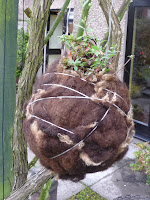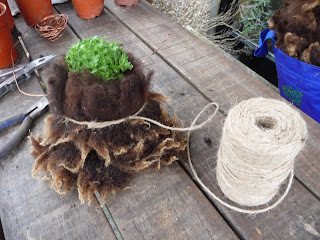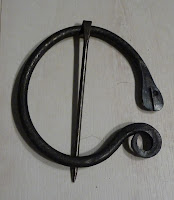When I told my friend Blonde Geraldine about it, she needed no persuasion, always up for shopping and learning how to do stuff. BG is much more art than craft, really, I should hate her. For the last three decades, whenever we have both got into some creative process, I will spend ages labouring over a basic item, while she throws it together, slapdash, what a mess. In the end, mine always looks pedestrian, hers fabulous. No prizes for guessing who did which of these garden paintings. Sick making, isn't it?
Well anyway, soon as I showed her the Wonderwool website, she spotted the hat competition.
Why not enter our fun Hat Competition, wear your hat to the show and on our special 'Hat Walk' where they will be judged.
Your hat can be made in any medium - knitting, crochet, woven, felted and should be made from wool or natural fibres. We are looking for innovative, fun, quirky hats, so get making.
The competition is open to all visitors to Wonderwool Wales.
Easter weekend, BG arrived at the house with a page of drawings and bags of confidence and sat me down to watch a woman on Youtube moulding and pinning a wet felt bag onto a hat shaped thing. How to block a wool felt hat. Diana Unterspan.
Still suffering post bag felting distress (see first blog ever), I was less sanguine about our chances of making the basis for a hat. However, I did have some proper white wool roving left over from when I was beginning to use a drop spindle and thanks to the blog, good advice from Angela, who wrote the felt bag instructions http://www.angelabarrow.co.uk/Blog/tutorial-seamless-felt-handbag

So, we had a go. We cut a resist the sort of shape of the felt bag seen on the Youtube hat video, layered nice clean roving over it, wet it and rubbed it down under a bit of netting, turned it over and did the same to the other side, this time spending lots of time rubbing the seams. Then the detail, which BG had decided would be lines of fine, fluffy, black mohair wool.
The rolling process in bubble wrap is much easier with two taking turns to put the kettle on and this time, with thinner layers of clean roving, the felt started to shrink pretty quickly. We could soon see the resist beginning to buckle inside. Also, the nice straight black lines went wiggly.
Took the resist out, excellent seams, perfect bag integrity, hooray! Then, lots of walloping it about to 'shock felt'. I hadn't anticipated that the flat shape would not be circular when three dimensional, but we had made a felt bag we could work with.
 The hat mould proved to be a three fag problem, which we resolved using a sawn off flower pot, topped with a nicely judged amount of rice in a plastic bag, as shown above. Not possible to pin the hat in position, but stretching the bag over it made the crown pretty much the same size as BG's head.
The hat mould proved to be a three fag problem, which we resolved using a sawn off flower pot, topped with a nicely judged amount of rice in a plastic bag, as shown above. Not possible to pin the hat in position, but stretching the bag over it made the crown pretty much the same size as BG's head.You really have to pull hard in all directions at once, but wet felt bags will give under sustained pressure. Still, no way could we stretch the sides out to make a flat brim - how do they do that?
The hat was not co-operating with BG's design plan, but never mind. We cut part of the brim off, wrinkled the rest into stylish folds and curves and left it to dry.

During the week, I crocheted and BG used a peg loom to make red flowers. Once dry, the felt hat holds its shape even if you sit on it by accident - if, of course one did, which, of course, one didn't.

The next weekend we could try it on - pith helmet style or sideways. I made an extra crochet flower, as presiding design genius, BG sewed them all on.
We have to be there by 2pm Saturday for the Hat Walk. All that remains is to pimp BG in the correct shade of lipstick and the remains of the felt as a wrap and I think we have a contender! There are going to be raw fleeces to see and touch and buy! Spinning wheels, drop spindles, buttons and workshops and a Ravelry Flock Evening. Win or lose, we'll have a booze.
When we get back on Sunday, I shall post photos of the Hat Walk and force myself to say nice things about the winner.
 BG being introduced on the runway - the crowd went wild.
BG being introduced on the runway - the crowd went wild.And sitting next to the winner, whose hat was lovely.

What a weekend - we are shattered, but have participated to the full. Not a stall unvisited, not a fleece I have not groped, not a silk cocoon BG has not peered inside and the scotch eggs were just as good everyone said.













































